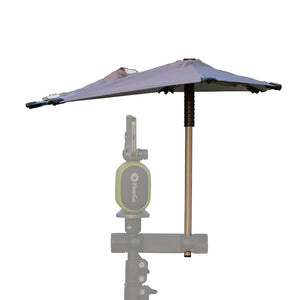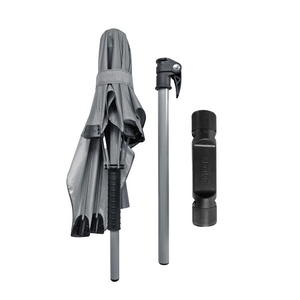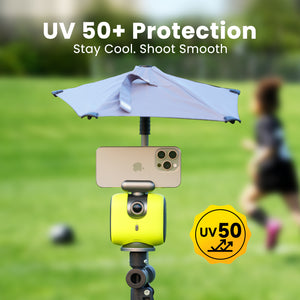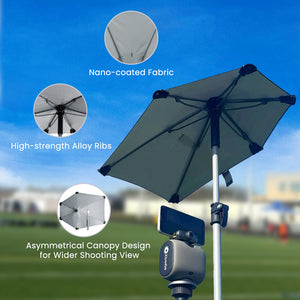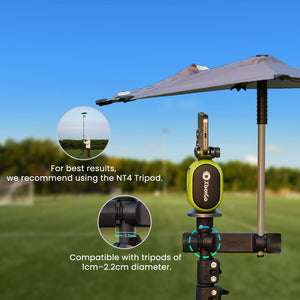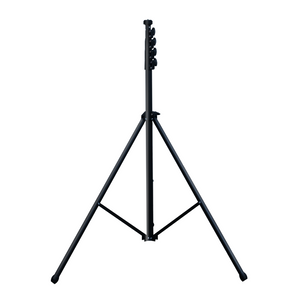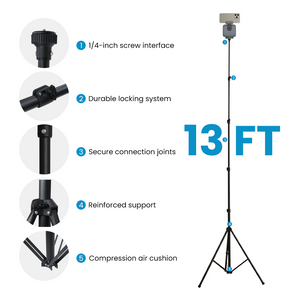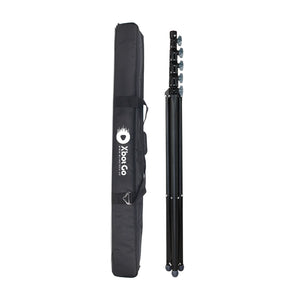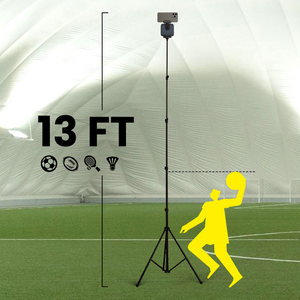XbotGo Chameleon AI Sports Camera
Soccer Goal Dimensions: Standards, Safety & Selection
You're watching the World Cup final, and a striker lines up for a crucial penalty kick. The goalkeeper stretches their arms wide, trying to cover as much of that massive frame as possible. Have you ever wondered why soccer goals are exactly that size? Or why your 8-year-old plays with smaller goals at weekend games?
Whether you're a parent shopping for backyard equipment, a coach setting up training fields, or simply curious about the beautiful game's specifications, understanding soccer goal dimensions is more complex than you might think. From FIFA's century-old standards to modern youth development practices, let's explore everything you need to know about soccer goal sizes.
Professional Soccer Goal Standards: The Universal Measurements
FIFA's Golden Standard
When it comes to professional soccer, there's no room for variation. FIFA established the official goal dimensions that have remained virtually unchanged since 1863:
- Width: 24 feet (7.32 meters)
- Height: 8 feet (2.44 meters)
- Post diameter: 4-5 inches (10.16-12.7 cm)
- Total goal area: 192 square feet
These measurements apply universally across all professional leagues - from the Premier League to MLS, from the Men's World Cup to the Women's Champions League. The posts and crossbar must be painted white and can be square, rectangular, round, or elliptical in shape.
The Perfect Balance
Why these specific dimensions? After decades of play, these measurements have proven to create the ideal challenge. At 192 square feet, the goal is large enough that even the tallest goalkeepers can't cover every angle - creating scoring opportunities for skilled shooters. Yet it's small enough that accuracy matters, preventing games from becoming shooting galleries.
Youth Soccer Goal Sizes: Building Skills Step by Step
Age-Appropriate Dimensions
US Youth Soccer has developed a progressive sizing system that matches player development:
|
Age Group |
Goal Size |
Playing Format |
Key Benefits |
|
U6-U8 |
6' × 4' |
4v4 or 5v5 |
Builds confidence, encourages shots |
|
U9-U10 |
18.5' × 6.5' |
7v7 |
Develops accuracy, keeper skills |
|
U11-U12 |
21' × 7' |
9v9 |
Transitions to full-field concepts |
|
U13+ |
24' × 8' |
11v11 |
Professional preparation |
The Development Philosophy
These progressive sizes aren't arbitrary - they're based on child development research. Smaller goals for younger players provide several crucial benefits:
Goalkeeper Development: Young keepers can actually reach the corners, building confidence and proper technique.
Shooting Accuracy: Rather than just blasting the ball, young players learn to pick their spots and develop precision.
Game Flow: Appropriate goal sizes maintain reasonable scoring rates, keeping games competitive and engaging.
Safety First: Smaller goals reduce the risk of injuries from oversized equipment and prevent discouragement from unrealistic expectations.
Real-World Confusion
Despite official guidelines, implementation varies widely. A common concern from parents on youth soccer forums: "Our rec league uses whatever goals the park has - usually full-size ones. My 8-year-old gets discouraged when every shot sails over his head."
This highlights a critical gap between recommendations and reality. Many recreational leagues, especially those sharing multi-sport facilities, struggle to provide age-appropriate equipment.
Specialized Formats: Beyond Traditional Soccer
Futsal: The Indoor Game
Futsal uses distinctly smaller goals to match its faster, more technical style:
- Dimensions: 10' × 6.5' (3m × 2m)
- Unique requirement: Posts must be a different color from the court
- Design philosophy: Smaller goals emphasize precision and quick reflexes
Small-Sided Outdoor Games
5-a-side: 12' × 4' goals create a fast-paced, high-scoring environment perfect for recreational leagues and training.
7-a-side: 12' × 6' goals serve as an ideal transition size for youth players moving toward full-field play.
Beach Soccer: Adapting to Sand
Beach soccer uses even smaller goals (5.5' × 7.3') to account for the challenging playing surface and acrobatic shooting style common in sand play.
Backyard Goals: Practical Choices for Home Practice
Finding Your Perfect Fit
Choosing a backyard goal involves balancing several factors:
Available Space: Measure your yard and subtract at least 10 feet behind the goal for safety. Remember to account for missed shots!
Age Range: If multiple children will use it, consider these versatile sizes:
- 8' × 6': Accommodates ages 6-12 comfortably
- 12' × 6': Good for serious players aged 10+
- 16' × 7': Near-regulation training for teens
DIY Solutions
Creative parents have shared innovative approaches:
- PVC pipe goals filled with sand for stability
- Adjustable designs that grow with children
- Rebounder combinations that return missed shots
Materials and Construction: What Makes a Quality Goal?
Professional Standards
Aluminum: The choice of top clubs worldwide. Lightweight yet incredibly durable, with powder-coated finishes that withstand years of weather. Aluminum goals used by Manchester United and Bayern Munich showcase the material's elite status.
Galvanized Steel: Offers professional-level stability at a lower cost. The zinc coating prevents rust, making it ideal for permanent installations at schools and parks.
uPVC (Plastic): Perfect for youth and recreational use. Modern high-impact plastics can withstand powerful shots while remaining light enough for easy setup and storage.
Safety Requirements
Modern goal safety has evolved significantly:
- All portable goals must be anchored or weighted (preventing tragic tipping accidents)
- Posts must have rounded edges with 4-5 inch diameters
- Regular inspection for wear, damage, or loose components is mandatory
- Wooden goals have been phased out due to splintering risks
Installation Choices: Permanent vs. Portable
Socketed Goals: The Professional Solution
Permanently installed in concrete sleeves, socketed goals provide:
- Maximum stability for competitive play
- Theft prevention for public facilities
- Consistent, regulation positioning
- Professional appearance
The downside? Once installed, they're essentially permanent fixtures requiring professional installation.
Freestanding Goals: Flexibility First
Portable goals offer unique advantages:
- Easy repositioning for different drills
- Seasonal storage in harsh climates
- Multi-purpose field compatibility
- Lower initial installation costs
However, they require proper weighting systems - typically sandbags, water barrels, or built-in counterweights.
The Women's Soccer Debate: Same Size, Different Discussion
The Height Disadvantage Question
With female goalkeepers averaging 5-6 inches shorter than their male counterparts, some have questioned whether women's soccer should use smaller goals. The debate highlights interesting perspectives:
Current consensus: FIFA, UEFA, and all major women's leagues maintain identical 24×8 foot goals.
The argument for change: Shorter keepers face mathematical disadvantages covering the same 192 square feet.
Investment Over Equipment Changes
Most women's soccer advocates argue that rather than changing equipment, the focus should be on:
- Better goalkeeper coaching from youth levels
- Increased investment in women's programs
- Recruiting taller athletes to goalkeeper positions
- Developing techniques that maximize reach and coverage
High School and College Regulations: Navigating Shared Facilities
NFHS (High School) Specifications
High school soccer faces unique challenges, particularly fields shared with football:
- Standard 24×8 foot goals required
- Portable goals must sit 2+ yards in front of football goalposts
- Many schools use custom-modified frames to accommodate both sports
- White color mandatory, with single manufacturer logo allowed
NCAA Standards: No Compromise
College soccer takes a stricter approach:
- Games cannot begin if goals don't meet exact specifications
- Any displacement or damage during play stops the game immediately
- Both men's and women's programs use identical dimensions
- Emphasis on professional-grade equipment and maintenance
Choosing the Right Goal: A Practical Framework
For Youth Organizations
Consider this decision matrix:
- League Requirements: Verify official dimensions for your age group
- Multi-Age Use: Adjustable or multiple goals may be cost-effective
- Storage Limitations: Folding designs save significant space
- Budget Planning: Calculate cost-per-year including replacement nets
For Home Use
Start with these questions:
- What's your available space? (Add 15+ feet of runoff area)
- What ages will use it? (Plan for 3-5 years of growth)
- How often will it be used? (Durability needs)
- Where will you store it? (Weather considerations)
Maintenance: Protecting Your Investment
Seasonal Care Checklist
Spring Setup:
- Inspect all joints and connections
- Check net integrity and attachment points
- Verify anchor systems
- Touch up paint if needed
Summer Use:
- Weekly net inspection for tears
- Monitor ground anchor stability
- Clean dirt/grass buildup from base
Fall/Winter Storage:
- Disassemble portable goals in harsh climates
- Store nets indoors to prevent UV damage
- Document any needed repairs for spring
Common Issues and Solutions
Based on community feedback, the most frequent problems include:
- Net deterioration (replace annually with heavy use)
- Joint loosening (regular tightening prevents failure)
- Ground erosion around permanent goals (requires periodic releveling)
- Paint chipping (annual touch-ups maintain appearance)
Future Trends: Where Goal Design is Heading
Smart Technology Integration
Emerging innovations include:
- Sensors that track shot speed and accuracy
- LED lighting for night play and goal celebrations
- Quick-connect systems for faster setup
- App connectivity for training data
Sustainability Focus
Environmental consciousness drives new developments:
- Recycled aluminum construction
- Biodegradable net materials
- Modular designs reducing waste
- Solar-powered accessories
Adaptive Designs
Future goals may feature:
- Height-adjustable crossbars for progressive training
- Width modifications for skill development
- Integrated rebounders for solo practice
- Collapsible designs for urban spaces
Making Your Final Decision
Selecting the right soccer goal requires balancing multiple factors. For competitive play, always verify your league's specific requirements - never assume standard sizes apply. For recreational use, prioritize safety and appropriate sizing over strict compliance.
Remember that the best goal is one that gets used regularly. A slightly smaller goal that fits your space and encourages daily practice beats a regulation goal that sits unused. Whether you're outfitting a professional stadium or creating a backyard practice area, understanding these standards helps ensure years of safe, enjoyable play.
The beauty of soccer lies not just in the goals scored, but in the skills developed along the way. By choosing the right equipment for your needs, you're not just buying a piece of equipment - you're investing in countless hours of practice, play, and passion for the beautiful game.
XbotGo Chameleon AI Sports Camera
Capture every moment with AI-powered tracking. Perfect for coaches, parents, and athletes who want seamless footage without manual filming.







 Soccer
Soccer Basketball
Basketball Ice Hockey
Ice Hockey Rugby
Rugby










